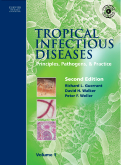|
|
|
| |
 |
|
|

|
 推薦指數:
推薦指數:





|
|
- 內容介紹
|
Tropical Infectious Diseases, 2nd Edition - Principles, Pathogens, & Practice, 2-Volume Set with CD-ROM
By Richard L. Guerrant, MD, David H. Walker, MD and Peter F. Weller, MD
1936 pages 820 ills
Trim size 8 5/16 X 10 7/8 in
Copyright 2006
Description
The reference JAMA called “an outstanding contribution” and “must reading” is back in a fully revised New Edition! This 2-volume set presents cutting-edge discussions of scientific principles, pathogenesis, pathophys-iology, diagnosis, treatment, and prevention for the full range of tropical infectious diseases. A new bonus CD-ROM, a clinical-focused organization, standardized life-cycle diagrams, and 850 illustrations make vital guidance easy to find and apply.
Reviews
REVIEWS OF THE PREVIOUS EDITION:
“Provides a sound scientific background for the subsequent consideration of each specific pathogen… An outstanding contribution and should become a classic in its field. It is must reading for all physicians working in tropical infectious diseases, and should be on the shelves of all physicians in the field of infectious diseases.”—JAMA
“Urge my fellow practitioners to run, not walk, to purchase [this] remarkable new textbook…[The] list of contributors from the United States and 16 other countries reads like an international who’s who in tropical medicine.”—Clinical Infectious Disease
New to this Edition
Features new chapters on Tropical Infectious Diseases Spreading Beyond Their Endemic Niches * Delusional Parasitosis * Obstetric Infections in the Tropics * and Barriers to Health.
Offers a bonus CD-ROM that contains the full text of the New Edition plus an image bank.
Provides a thorough overview of the latest developments in immunology, pathogenesis, genetics of virulence, and new molecular approaches to diagnosis and control.
Integrates the expertise of many new contributing authors.
Includes many new life-cycle diagrams … expanded clinical information on malaria
Table of Contents
PRINCIPLES AND GENERAL CONSIDERATIONS
1. Principles of Parasitism: Host Parasite Interactions 2. Factors in Influencing Geographic Distribution and Incidence of Tropical Infectious Diseases 3. Epidemiology in Tropical Medicine 4. Population Dynamics of Infectious Diseases in the Tropics 5. Social and Cultural Factors in Tropical Medicine 6. Nutrition-Infection Interaction 7. Micronutrients in Infection 8. Host Genetics and Susceptibility to Infection 9. Disease Eradication and Control 10. Travelers’ and Immigrants; Health 11. Military Populations 12. Vector Biology 13. Animal Poisons in the Tropics 14. Plant Toxins in the Tropics 15. HIV and AIDS in the Tropics 16. Immunology, Host Defense, Immunodeficiencies, and Vaccines 17. Tropical Infectious Diseases and Malignancy 18. Chemotherapy of Parasitic Diseases 19. Chemotherapy of Bacterial, Fungal, and Viral Diseases 20. Surveillance for Emerging Diseases 21. Distinguishing Bioterrorism from Endemic Tropical Infections
PATHOGENS
A. Bacterial and Mycobacterial Infections
22. Eneric Escherichia coli 23. Typhoid Fever 24. Nontyphoidal Salmonellosis 25. Shigellosis 26. Campylobacter Infections 27. Cholera 28. “Noncholera” Vibrio Infections 29. Enteric Clostridium Infections 30. Helicobacter pylori Infections 31. Meningococcal Infections 32. Genococcal and Other Neisserial Infections 33. Haemophilus Infections 34. Calymmatobacterium granulomatis Infections 35. Pneumococcal Infections 36. Streptococcal and Staphylococcal Infections 37. Pertussis 38. Legionellosis 39. Meliodosis 40. Diptheria 41. Tuberculosis and Atypical Mycobacterial Infections 42. Leprosy 43. Anthrax 44. Bartonelloses 45. Brucellosis 46. Plague 47. Tetanus
B. Spirochetal Infections
48. Treponemal Infections 49. Relapsing Fever 50. Leptospirosis
C. Chlamydial Infections
51. Trachoma 52. Chlamydia trachomatis Infections of the Genital Tract 53. Psittacosis
D. Rickettsial and Ehrlichial Infections
54. Spotted Fever Group Rickettsioses 55. Typhus Group Rickettsioses 56. Scrub Typhus 57. Ehrlichioses 58. Q. Fever
E. Fungal Infections
59. Dermatophytosis 60. Mycetoma 61. Chromoblastomycosis and Phaeohyphomycosis 62. Histoplasmosis, Blastomycosis, Coccidiodomycosis, Paracoccidiodomycosis 63. Penicilliosis marneffei 64. Candid Infections 65. Enomophthoramycosis, Lobomycosis, Rhinosporidiosis, and Sporotrichosis 66. Pneumocystosis
F. Protozoan Infections
67. Enteric Amebiasis 68. Intestinal Flagellate and Ciliate Infections 69. Intestinal Coccidial Infections 70. Malaria 71. Babesiosis 72. African Trypanosomiasis 73. American Trypanosomiasis (Chagas’ Diseases) 74. Leishmaniasis 75. Free-Living Amebae 76. Non-intestinal Flagellates 77. Systemic Coccidian 78. Microsporidiosis
G. Nematode Infections
79. FilariasisLoiasis and Mansonella Infections 80. Onchocerciasis 81. Zoonotic Filariasis 82. Dracunculiasis 83. Toxocariasis and Larva Migrans Syndromes 84. Trichinellosis 85. Angiostrongyliasis 86. Other Tissue Nematode Infections 87. Enterobiasis 88. Trichuriasis 89. Ascariasis 90. Hookworm Infections 91. Strongloidiasis
H. Cestode Infections
92. Overview of Cestode Infections 93. Taeniasis 94. Cysticercosis 95. Diphyllobothriasis 96. Echinococcosis 97. Other Cestode Infections
I. Trematode Infections
98. Schistosomiasis 99. Liver, Lung, and Intestinal Fluke Infections
J. Viral Infections
100. Measles 101. Human Herpesvirus 102. Smallpox and Monkeypox 103. Influenza Virus 104. Enterovirus Infections, Including Poliomyelitis 105. Rotavirus Infections 106. Calicivirus Infectins 107. Astrovirus 108. Hepatitis 109. Overview of Viral Hemorrhagic Fevers 110. Arenavirus Infections 111. Bunyaviral Fevers 112. Hantavirus Infections 113. Other Bunyavirus Infections 114. Filovirus Infections 115. Yellow Fever 116. Dengue and Dengue Humorrhagic Fever 117. Alphavirus Infectins 118. Rabies
K. Retroviral Infections
119. AIDS and AIDS-Related Infections
L. Ectoparasitic Infections
120. Arthropids, Tongue Worms, Leeches, and Arthropod-Borne Diseases
PRACTICE APPROACH TO PATIENTS
121. Health Advise to International Travelers 122. Gastrointestinal Symptons 123. Fever and Systemic Symptoms 124. Eosinophilia 125. Cutaneous Lesions 126. Hepatobiliary Diseases 127. Pulmonary Diseases 128. Ocular Diseases 129. Neurologic Diseases 130. Anemia 131. Urologic Symptons 132. Sexually Transmitted Diseases 133. The Human Immunodeficiency Virus and Coinfecting Tropical Infectious Diseases 134. Travel-Related Health Concerns Associated with Extremes of the Environment
|
|
|

